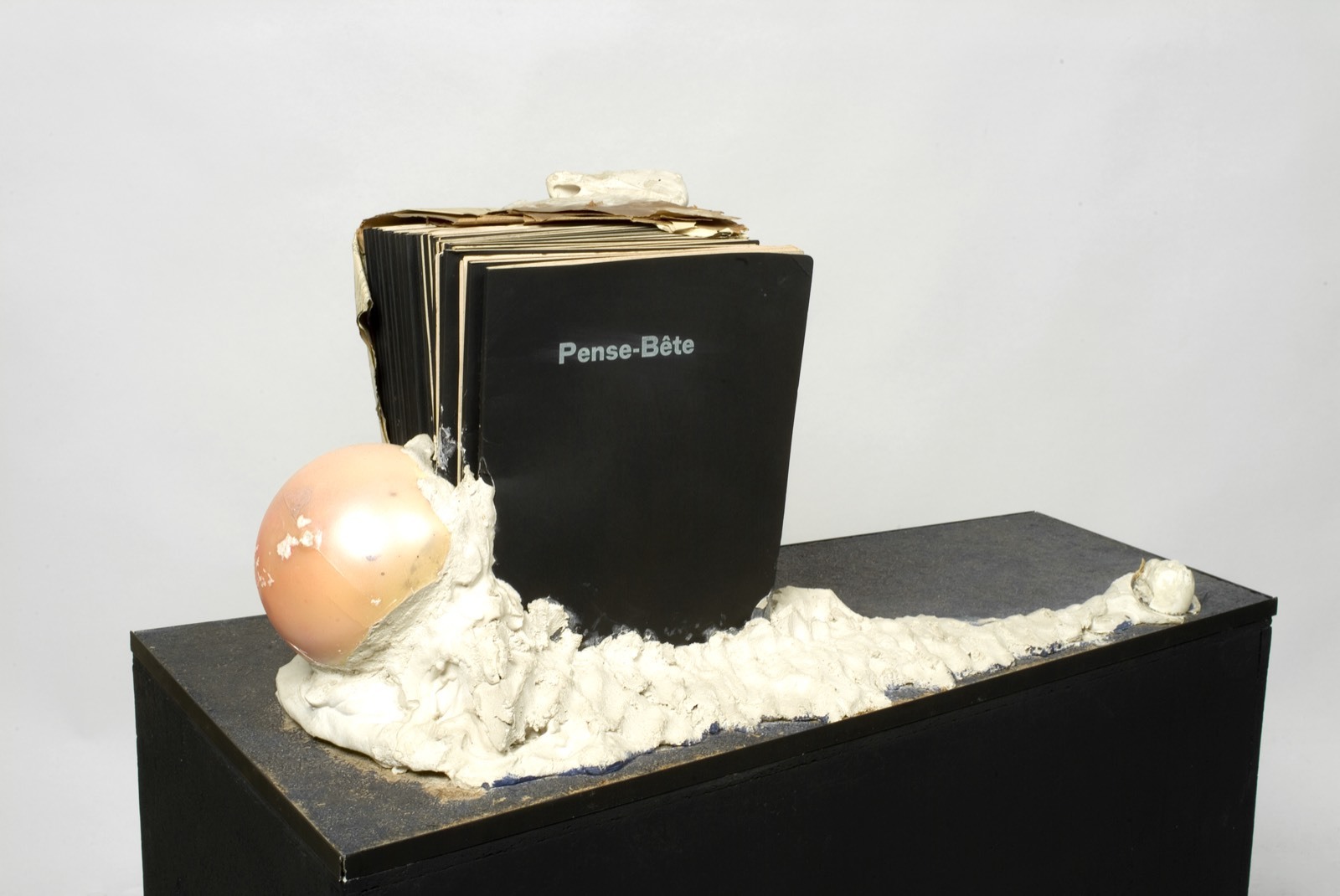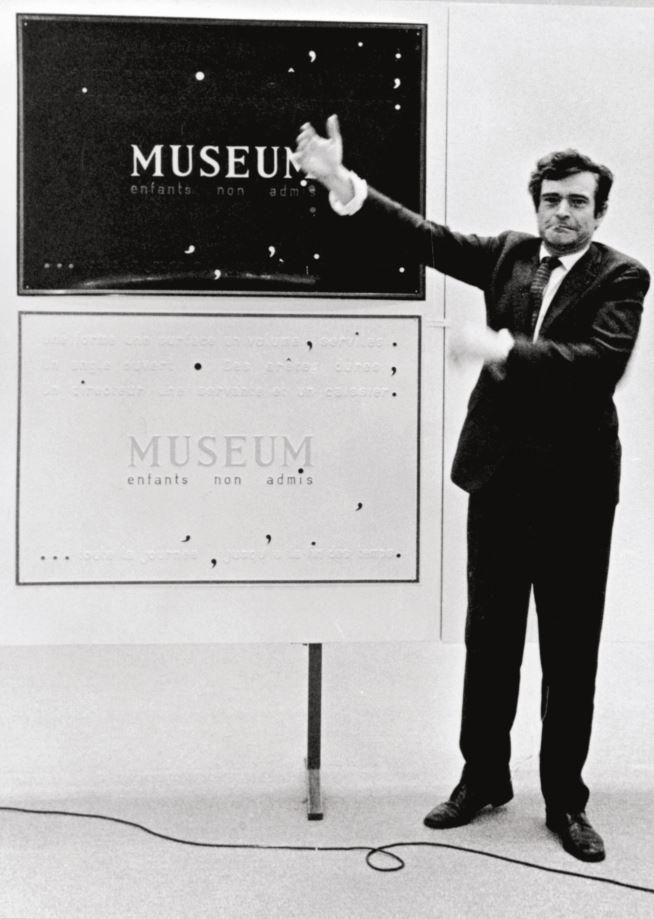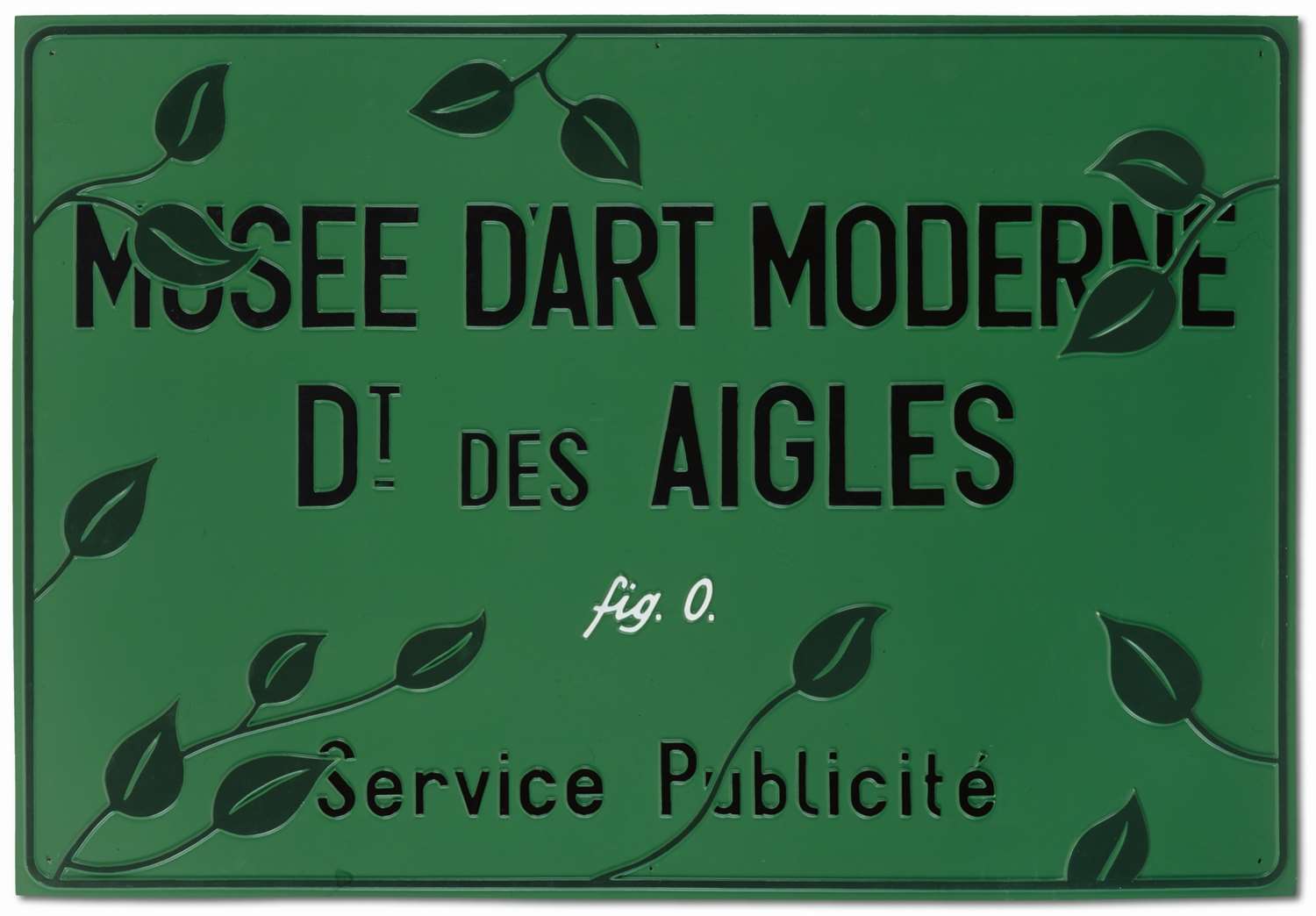
Marcel Broodthaers’s career as a visual artist begins where his career as a poet — in the traditional poems-on-paper sense — comes to an abrupt end: in 1964, in an oblong blob of plaster. The work, La Pense-Bête, stands as a cenotaph to earnest meaning. “I, too, wondered whether I could not sell something and succeed in life,” Broodthaers writes in the exhibition prospectus. “For some time I had been no good at anything. I am forty years old… Finally the idea of inventing something insincere crossed my mind and I set to work straightaway.”1

Forty-four copies of Broodthaers’s last book of poems stand upright, closed and partially wrapped in newspaper, in a haphazard glob of plaster. A faded-orange orb like a shattered buoy (the Tate Gallery’s 1980 retrospective calls it “nacreous”) nestles in the high mound of plaster at the books’ spines. A plaster egg is crushed into the far end of the agglomeration, where it peters into the inked fiberboard base.
La Pense-Bête’s plaster mass sits in S.M.A.K (acronym for “Stedelijk Museum voor Actuele Kunst”). I visited S.M.A.K. in October 2021, part of a weeklong march through Belgium’s art museums, the day after my first introduction to Broodthaers: an exhibit of his Industrial Poems at WIELS (not an acronym, capitalized anyway).
The Industrial Poems are a series of 120 plaques manufactured in groups of seven between 1968 and 1972. The signs are glossy plastic, vacuum-formed on plywood matrices and then painted. In a self-published self-interview, Broodthaers facetiously points out “[t]hese plaques are fabricated like waffles.”2
Each sign sports color-blocking unique in its group. Though they have a common formed surface, the paint selects which raised features to foreground and which to leave back. Seven plaques from the same mold suggest different meanings through selective emphasis: one highlights just diacritic marks; another highlights certain words; another certain other words; and so on. Though any plaque, taken individually, is cryptic, their arrangement together invites a game of subset-selection: “perhaps some different subset of these words/shapes holds the meaning.” Broodthaers refers to the plaque-puzzles as “rebuses,” intentionally opaque demonstrations of the “difficulty of reading that results when you use this substance.”3

That “difficulty of reading” is the central concept of Broodthaers’s oeuvre, a thread he started pulling in that 1964 inaugural exhibit. La Pense-Bête, he writes, turned a book into “the object of a prohibition:”
I took a bundle of fifty copies of a book called Pense-Bête and half-embedded them in plaster. The wrapping paper is torn off at the top of the “sculpture,” so you can see the stack of books (the bottom part is hidden by the plaster). Here you cannot read the book without destroying its sculptural aspect. It is a concrete gesture that passes the prohibition on to the viewer — at least that’s what I thought would happen.4
The thread continues through his other work. A 2019 Ghent exhibition of unreadable books called Broodthaers a “leader of illegibility.”5 Through blacked-out concrete poetry, text on crumpled packing paper, miniscule atlases, and cat interviews, Broodthaers explores tantalizing illegibility. Sometimes, as with La Pense-Bête, there’s a sculptural “prohibition.” By contrast, the Industrial Poems are sculpturally legible but dubiously meaningful, at least in a direct way — are they cryptic, or are they entirely nonsensical?

Unsurprisingly, commentaries on Broodthaers often connect his fixation with meaning to contemporary semiology. These are the 1960s in francophone Europe: Jacques Derrida is dissolving structuralist linguistics into a phenomenological fever-dream, and Roland Barthes is announcing La mort de l’auteur (1967). Broodthaers shares their solidarities — when Paris’s universities spark the May 68 general strike, he occupies the Brussels Palais des Beaux-Arts — and makes insincere references to their work: “[h]is comment on Magritte takes the form of directing the reader to Michel Foucault’s essay ‘Ceci n’est pas une pipe,’ which at that time existed only as a published lecture that [he] had almost certainly not read.”6
Art historian Benjamin H.D. Buchloh relates Broodthaers’s illegibility (“the linguistic sign becoming the object of semiological and poetical decomposition”) to Ferdinand de Saussure’s bipartite theory of signs: the separation of a signifier — an image or an utterance or what have you — from a signified, that concept it represents.7 In practice, the jump from signifier to signified can appear so automatic Saussure’s distinction seems pedantic. An iconographic signifier (e.g. the illuminated seatbelts-fastened sign in an airplane) visually resembles its signified (you buckling your damn seatbelt). But signs aren’t always so direct. An illustrated eagle could iconographically signify a certain bird, but it could also represent a heraldic national identity; same sign, different signifieds!
For Buchloh, Broodthaers’s industrial poems assert the Saussurean dichotomy by refusing to usefully fulfill it. Rather than presenting a straightforward signified, their writing “refuse[s] the visual or sensual data which the viewer demands.” Maybe they’re cryptic — signifying something inaccessible — but we can’t rule out that they’re nonsensical, they signify nothing at all! Buchloh calls these ‘anomic objects,’ defined by their “withdrawal from systems of communication, [their] self-imposed condition of muteness and silence.”8 Whereas La Pense-Bête prohibited reading by embedding books in plaster, the Industrial Poems allow reading but inhibit its automatic effect (the reader’s translation from sign to signifier).
Ethnographer Michael Oppitz, on the other hand, identifies Broodthaers with Roland Barthes’s reaction to Saussure, wherein signifier and signified are more weakly coupled by the interpreting reader.9

My lasting impression from the WIELS exhibit is that both Buchloh and Oppitz miss an opportunity to treat the Industrial Poems as objects first and foremost. By considering the plaques differently, we can reconsider how a museum should stage encounters with meta-referential art.
In essence, this requires a generalizing step-back from signs to tools. In general, Saussure treats each instance of a sign (e.g. the inked imprint of a word) as a tool for meaning-making. For the most part — as with our automatic interpretation of the seatbelts-fastened indicator — they signify smoothly, so long as they belong to a familiar lexicon or fit into a familiar structure. “We read in two ways,” he writes: “a new or unknown word is spelled out letter by letter; but a common, ordinary word is embraced by a single glance, independently of its letters, so that the image of the whole word acquires an ideographic value.”10
The difference between familiar (automatic) and unfamiliar (letter-by-letter) signs mirrors Heidegger’s notion of the tool ready-to-hand (zuhandenheit), a sort of teleological status where an object disappears into a task without you having to think about it. When you’re hammering nails, the hammer-as-object disappears into the hammer-as-purpose. You don’t consider this hammer. You just hammer.11
You’re rudely introduced to the tool-analogue of Saussure’s unfamiliar sign when you take a swing and the head of the hammer flies off. A broken hammer refuses to be reduced, invisibly, to its purpose. You can only get back to the purpose (the bliss of hammering) by considering this hammer as an object (or, suddenly, two objects). How did it break? What are the handle and head materials? How are they textured? The broken tool interrupts its own invisibility, the same way an unfamiliar word interrupts ideographic reading and forces you to consider the individual letters.
If the Industrial Poems were just words, Heidegger’s tool-phenomenology wouldn’t tell us anything Saussure can’t. They’re more than words: they’re tools with words on them! Whereas Saussure’s familiarity model implies a one-way flow of signifiers (from unfamiliar to familiar), Heidegger’s tool analysis allows familiar objects to become unfamiliar. That’s how the plaques function: they appear legible at first.
Broodthaers’s promotional materials cautioned his audience against reducing the Industrial Poems to semiological demonstrations. “What kinds of simpletons do you catch with your plaques?” he asks himself; “those who take these plaques for pictures and hang them on their walls. Although there’s no proof that the real simpleton isn’t the author himself, who thought he was a linguist able to leap over the bar in the signifier/signified formula, but who might in fact have been merely playing the professor.”12 The Tate Gallery delivers a direct caution. Because “[t]he plastic panels contain a series of puzzles with no solution […] the sophisticated, unable to read them, but recognizing them as signs, would perhaps find in them an art of semiology — but they would be wrong.” Like the other object-assemblages Broodthaers exhibited (the books in plaster, the miniscule atlas, etc.), the Industrial Poems’ “meaning was primary and had no status as metalanguage. They are made up of elements drawn from the culture but do not directly comment on it or describe it.”13
This deepens Broodthaers’s prohibition on intelligibility: you can’t discern a direct meaning from the Industrial Poems, and you’re instructed to avoid secondarily interpreting them as the didactic expression of a semiotic concept.
Moreover, the Industrial Poems take the form of plaques. A museum is full of plaques-as-tools, sometimes descriptive — little white museum labels — and sometimes prohibitive. Broodthaers’s Industrial Poems camouflage themselves as tools in the tool-world of signage. Some even purport to be museum signs, bearing museum-specific descriptions (e.g. Porte A) or prohibitions (e.g. Museum. Enfants non admis). That camouflage invites an unwitting viewer to see them as tools first, and to run headlong into interruption when their signifiers make no sense.

That risk-of-interruption is a function of the Industrial Poems’ status as tool objects. If you reduce them to their rebuses — present them as prints, say, with pictureframes, behind glass — the trap of their brittle readiness-to-hand gives way to an actual, unbroken readiness-to-hand as art objects.
Oppitz remarks that René Magritte was “unable to protect his painting [The Treachery of Images] against the art-historical significance it would acquire […] as art object,” and hopes Broodthaers’s work fares better.14 Broodthaers designed the Industrial Poems with similar concerns in mind, fears developed in what he saw as the failure of La Pense-Bête. He thought his concrete gesture would render La Pense-Bête illegible, but he’d inadvertently formed an art object for which that prohibition held no weight: their status as art stripped the books of their status as books.
viewers reacted quite differently from what I had imagined. Everyone so far, no matter who, has perceived the object either as an artistic expression or as a curiosity. “Look! Books in plaster!” No one had any curiosity about the text; nobody had any idea whether this was the final burial of prose or poetry, of sadness or pleasure. No one was affected by the prohibition.15
The Industrial Poems’ advantage is their subtlety, the possibility that they can slip — at least for a moment, for an unfamiliar viewer — out of the world of art, into the world of tools. Their plasticity plays a special role. “These plaques,” Broodthaers explains in his introduction to their exhibition, “occupy the border between object and image. According to their mechanical production they seem to deny their status as art objects.”16 At WIELS, the painstakingly comprehensive display of Industrial Poems undermined this denial and ensuing surprise: mounting the Poems in sets from the same mold invites the viewer to try comparative interpretation or, worse, to lose the individual plaques in the candy-colored mass of the edition.
Memorably, I saw one more Industrial Poem in a dim corner of Mu.ZEE in Ostend. It was a surprise, not least because of its slippery crimson-and-gold shine (on a floor of blue-green pontilists, in the greyest city in the world). The plaque seems utilitarian there, even commercial; even if you discern the irony, you could mistake it for the same tongue-in-cheek trendiness forcing the capitalized museum names. It’s too bad my recognition prevented me puzzling over the French.
Broodthaers, of course, exhibited the Industrial Poems together. Unlike WIELS, his 1972 exhibition bore a disclaimer on every object, “a label saying either in French, German, or English ‘This is not a work of art!’”17
If they’re not works of art, nor intelligible texts, nor didactic semiology, how should you consider them? Broodthaers’s prospectus for his inaugural solo exhibition, the one that entombs his poetry and declares his insincerity, at least appears to support my hunch.
CE QUE C’EST?
EN FAIT, DES OBJETS.
WHAT IS IT?
IN FACT, IT IS OBJECTS.